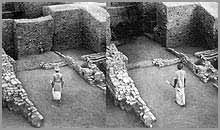Replicating Truths
 The creation of ‘visual replica’ for ancient ruins and historical monuments has a long history outside photography and India. As scholars focused attention on first hand studies of phenomena, their reliance on illustrations, which could effectively transmit their own ‘true’ vision, grew in scale. In Britain, one of the earliest and most comprehensive samples of illustrated ‘facts’ are the drawings made by William Stukeley, the first Secretary of the Society of Antiquaries of London, who was of the strong opinion that “without drawing or designing the Study of Antiquities or any other Science is lame and imperfect” (in the first minute of the Society, 1717, also quoted in Piggot 1978, p.1, Figure 15).
The creation of ‘visual replica’ for ancient ruins and historical monuments has a long history outside photography and India. As scholars focused attention on first hand studies of phenomena, their reliance on illustrations, which could effectively transmit their own ‘true’ vision, grew in scale. In Britain, one of the earliest and most comprehensive samples of illustrated ‘facts’ are the drawings made by William Stukeley, the first Secretary of the Society of Antiquaries of London, who was of the strong opinion that “without drawing or designing the Study of Antiquities or any other Science is lame and imperfect” (in the first minute of the Society, 1717, also quoted in Piggot 1978, p.1, Figure 15).
Over the next hundred years, and by the middle of the nineteenth century, illustrations, not only of the landscape and artifacts, but also of aspects of the physical tasks that were undertaken during archaeological surveys, including the removal of artifacts, became integral to archaeology’s iconography. Rules for archaeological photography, which were well established by the mid-twentieth century, were clearly developed upon this prerogative, and as M.B. Cookson, who photographed Mortimer Wheeler’s excavations at Maiden Castle (1934–38) and Harappa (1946–47) stressed, “should the human figure be used, it must have the appearance of being employed; i.e., it should not be staring at the camera but should be posed in the action of doing something” (1946, p. 136). By dehumanizing the presence of people within “archaeological photography” (ibid, p. 134), photographs were to verify the methodical extraction of archaeological evidence (Figure 16).
and Harappa (1946–47) stressed, “should the human figure be used, it must have the appearance of being employed; i.e., it should not be staring at the camera but should be posed in the action of doing something” (1946, p. 136). By dehumanizing the presence of people within “archaeological photography” (ibid, p. 134), photographs were to verify the methodical extraction of archaeological evidence (Figure 16).
As mentioned earlier, Petrie had enunciated many norms for correct photography for archaeological purposes. His rules were not new. They were based on those that were generally followed by excavators and explorers, such as Putnam and Pitt Rivers, and were needed, by the late-nineteenth century, to create effective contrasts between their supposedly methodical field surveys, and the treasure seeking’ and ‘booty hunting’ expeditions that were regularly undertaken by many others. Considering that the two types of surveys and excavations were rather similar in their execution throughout the nineteenth century–– and this we may also perceive from Cunningham’s field explorations that were more akin to pilfering than to any systematic digging––rules for photographing sites and antiquities offered the visual distinction that was intellectually required to distinguish the ‘scientific’ work-practice of the archaeologists and antiquarians. Photography could, thus, be effectively used to mask the fact that most excavations, archaeological and looting, were often indistinguishable in practice.
